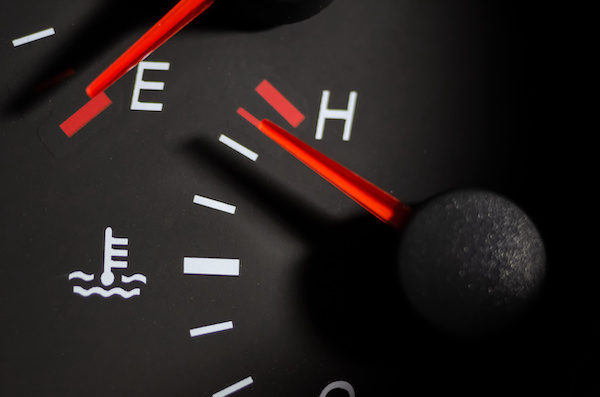The temperature gauge in a car should ideally read between 195°F to 220°F during normal driving conditions. The gauge may fluctuate slightly, but it should not consistently reach extreme levels.
The temperature gauge in a car is an important indicator of the engine’s operating temperature, ensuring that it remains within a safe range. An excessively high or low reading can signal potential issues with the cooling system or engine performance, necessitating immediate attention to avoid damage.
Understanding the ideal temperature range for the gauge and monitoring it regularly can help prevent costly repairs and ensure the smooth functioning of the vehicle. Establishing a routine of checking the temperature gauge can contribute to the overall maintenance and longevity of the car.
Common Causes Of Temperature Fluctuations
Temperature fluctuations in a car can be caused by various factors, such as low coolant levels, a faulty thermostat, or a malfunctioning radiator fan. It is important for the temperature gauge in a car to read within the normal range to ensure optimum performance and prevent overheating.
Radiator Issues
Temperature gauge reading in a car can fluctuate due to various reasons. Here are some common causes to be aware of:Coolant Levels
Low coolant levels can lead to overheating in your car.Thermostat Malfunction
A faulty thermostat can cause temperature gauge deviations in your vehicle.Stay informed about these issues to ensure your vehicle runs smoothly.
Credit: www.wardtires.com
Ideal Temperature Range For A Car
When it comes to the temperature of your car, maintaining the ideal range is crucial for its smooth and efficient operation. The temperature gauge in your car provides valuable information about the engine’s temperature, ensuring that it stays within safe parameters to prevent damage and overheating.
Manufacturer’s Specifications
The manufacturer’s specifications are the best resource for determining the ideal temperature range for your car. Each car model may have slightly different temperature requirements based on its design and engine specifications. It is important to consult the owner’s manual or contact the manufacturer to get accurate information specific to your vehicle.
Signs Of Overheating
Recognizing the signs of overheating is essential for maintenance and avoiding costly repairs. If your car’s temperature gauge starts creeping into the danger zone, it is a clear indication that your engine may be overheating. Other signs include steam or smoke coming from the engine, a sweet smell of coolant or radiator fluid, or dashboard warning lights illuminating.
- Temperature gauge creeping into the red zone
- Steam or smoke coming from the engine
- Sweet smell of coolant or radiator fluid
- Dashboard warning lights illuminating
It is crucial to address these signs promptly to prevent further damage to your car’s engine. Failure to act can lead to engine failure, which can be both costly and inconvenient.
Importance Of Monitoring Car Temperature
Car temperature is a crucial factor in ensuring the smooth operation of your vehicle. Monitoring the temperature gauge in your car is essential for preventing potential engine damage and ensuring optimal performance. Neglecting to keep an eye on the temperature gauge can lead to costly repairs and inconvenience. In this post, we’ll delve into the importance of monitoring your car’s temperature and the recommended temperature readings to maintain for a well-functioning vehicle.
Preventing Engine Damage
Monitoring your car’s temperature is critical for preventing engine damage. When the engine overheats or operates at a temperature higher than normal, it can lead to severe damage to various engine components, such as the piston rings, cylinder walls, and gaskets. Regularly monitoring the temperature gauge allows you to address any overheating issues promptly, preventing potential engine damage and costly repairs.
Ensuring Optimal Performance
Maintaining the right temperature range in your car is key to ensuring optimal performance. A car that operates at the ideal temperature range performs efficiently and delivers better fuel economy. By monitoring the temperature gauge, you can address any deviations from the optimal temperature range and take necessary actions to maintain your car’s performance at its best.
How To Check The Temperature Gauge
The temperature gauge in your car is an essential indicator of your engine’s health. Regularly checking the temperature gauge can help prevent overheating and other potentially costly problems. Here’s how to check the temperature gauge and ensure your vehicle is running at the right temperature.
Dashboard Display
The temperature gauge on your car’s dashboard is a crucial tool that provides real-time information about the engine’s operating temperature. It is usually represented by a needle on a dial, with a range indicating the normal operating temperature. The ideal reading for most vehicles is right in the middle of the gauge, typically between the “C” for cold and “H” for hot. If the needle moves into the red “hot” zone or if the temperature gauge displays an abnormally high reading, it indicates a potential overheating issue.
Using An Obd2 Scanner
An OBD2 scanner is a valuable tool that can provide more detailed information about your vehicle’s performance, including the temperature of various engine components. To check the temperature gauge using an OBD2 scanner, you can connect the scanner to the OBD2 port, typically located under the dashboard. Once connected, access the live data section on the scanner to read the current engine temperature. Comparing this reading with the temperature gauge on the dashboard can provide a more comprehensive understanding of your engine’s temperature.
Steps To Take If Gauge Reads Abnormal Temperatures
Steps to Take If Gauge Reads Abnormal Temperatures
When the temperature gauge in your car starts showing abnormal readings, it is crucial to take immediate action to prevent any further damage. Ignoring the warning signs can lead to overheating and potential engine failure. Follow these steps to ensure your safety and the well-being of your vehicle.
If you notice that the temperature gauge is reading abnormally high or low, the first step is to pull over to a safe location as soon as possible. Find a spot away from traffic where you can safely park your car. This will allow your engine to cool down and prevent further damage.
After pulling over safely, the next step is to check your coolant levels. Coolant plays a vital role in maintaining your engine temperature. Open the hood of your car and locate the coolant reservoir. Use caution as it may be hot. Check the coolant level and make sure it is within the recommended range. If the coolant level is low, you will need to add more coolant.
If the coolant level is normal, the next step is to inspect for any coolant leaks. Coolant leaks can cause a decrease in coolant levels, leading to overheating. Look for any visible signs of coolant leakage, such as puddles under your car or a sweet smell. If you notice a leak, it is essential to address it promptly to prevent further issues.
Radiator fans play a crucial role in keeping your engine cool. If the temperature gauge is reading abnormally high, check if the radiator fans are functioning correctly. Turn on your car’s engine and let it idle while monitoring the fans. If you notice that the fans are not turning on or are not spinning at the proper speed, there may be an issue with the fan relay or motor that needs attention.
If you have followed these steps and the temperature gauge continues to display abnormal readings, it is recommended to seek professional assistance. An experienced mechanic can diagnose the issue and provide the necessary repairs or maintenance to ensure your vehicle’s optimal performance.
Remember, taking immediate action when your temperature gauge reads abnormal temperatures is crucial for your safety and the longevity of your car. By following these steps, you can address the problem promptly and prevent any further damage.

Credit: bigcoupe.com
Maintenance Tips To Prevent Temperature Issues
Ensure your car’s temperature gauge reads within the normal range, typically around the middle mark. Regularly check and top up coolant levels, as low levels can lead to overheating. Maintain your vehicle’s cooling system to prevent temperature-related issues, ensuring a smooth and safe drive.
Maintenance Tips to Prevent Temperature Issues Regular InspectionsRegularly check the temperature gauge to ensure it’s within the normal range.Inspect the radiator for any signs of corrosion or leaks.Coolant FlushesSchedule coolant flushes as per the manufacturer’s recommendations.Use a 50/50 mix of coolant and water for optimal engine cooling.Ensuring Proper Cooling System FunctionalityKeep an eye on the cooling system components for any wear or damage.Check the thermostat to ensure it’s functioning correctly.Replace worn hoses and belts to prevent overheating issues.Importance of Proper MaintenanceProper maintenance helps prevent costly repairs down the line.Overall, regular checks and maintenance are crucial for a healthy cooling system.Consulting A Mechanic For Temperature Concerns
If you are experiencing temperature concerns with your car, consulting a mechanic is crucial to identify the ideal temperature gauge readings. Proper assessment of the temperature gauge reading ensures effective performance and prevents potential issues. Seeking professional assistance will help maintain and optimize your car’s temperature levels.
Diy Vs. Professional Help
Understanding Repair Costs
Consulting a mechanic for temperature concerns is crucial to prevent any potential issues with your car’s cooling system. A professional inspection can help determine the root cause of abnormal temperature readings and prevent costly repairs.
DIY troubleshooting might be tempting, but it’s best to leave temperature-related problems in the hands of a skilled mechanic. A professional can accurately diagnose and repair any issues to ensure your safety on the road.
Diy Vs. Professional Help
- Consult a mechanic for accurate diagnosis.
- Avoid DIY repairs for complex issues.
- Professional help ensures long-term vehicle health.
Understanding Repair Costs
- Consulting a mechanic can help you understand repair expenses.
- Professional guidance minimizes unnecessary costs.
- Proper repairs prevent additional expenses down the road.

Credit: m.facebook.com
Conclusion
To ensure your car’s engine runs smoothly, it is crucial to understand what temperature the gauge should read. Overheating is a common issue that can lead to serious problems if not addressed promptly. Keep an eye on your temperature gauge and make sure it stays within the recommended range.
Regular maintenance and proper engine care are key to avoiding engine overheating and potential damage. Stay informed and stay safe on the road!


